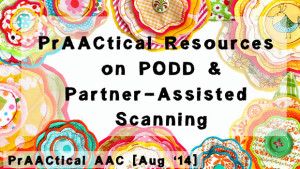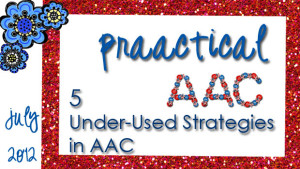February 4, 2015
by Carole Zangari -

Most of us learn better when we get to see examples of how things are done. In AAC, we don’t have nearly enough examples to learn from so I’m always grateful when someone agrees to show us how they implement particular tools or strategies. Today, we send a big prAACtical “Thank You” to Jack and Mary-Louise in Australia. When children have significant motor limitations, partner-assisted scanning may be their best option for message selection. In this video, Jack and Mary-Louise show us how they use a combination of visual and auditory scanning. Mary-Louise points to choices in his PODD book and says the message aloud so Jack can consider his options. Jack does his part by signaling when he sees/hears a desired message. Because his body is terribly unoccoperative, he signals in a few different ways (i.e., ‘Yes’ with vocalization, eyebrow raises, head nods, &/or eye gaze, and ‘No’ with a... [Read More...]
Filed under: PrAACtical Thinking
Tagged With: auditory scanning, Jack White, Mary-Louise Bertram, partner assisted scanning, PODD book, visual scanning
August 20, 2014
by Carole Zangari -

Some resources to explore…
Filed under: PrAACtical Thinking
Tagged With: partner assisted scanning, PODD
August 26, 2012
by Carole Zangari -

This week, we return to the team at the Autism and Tertiary Behavior Supports Project of the Kansas Technical Assistance Network. They have two wonderful videos by Jane Goetz and Lori Chambers on Pragmatically Organized Dynamic Displays. You can view ‘It’s All About the Interaction,” Part 1 and Part 2 . Also, look for the handout and tip sheet that accompanies these videos. –
Filed under: Video of the Week
Tagged With: ASD, cerebral palsy, communication, communication book, developmental disability, intervention, partner assisted scanning, PODD, resources
August 12, 2012
by Carole Zangari -

Awhile back, we listed a few strategies that seem to be under-utilized in AAC. One of those is partner assisted scanning, a strategy we love for its boundless flexibility. In this week’s video we turn to the Cincinnati Children’s Hospital Medical Center’s Aaron W. Perlman Center. Tune in for a clear description of the strategy and lots of wonderful examples. You can learn more from them here. – –
Filed under: Video of the Week
Tagged With: access, partner assisted scanning
July 14, 2012
by Carole Zangari -

1. Partner-assisted scanning (PAS) offers great flexibility and spontaneity. Don’t want to take your SGD to the beach? A print-out of the screens and PAS is a great option. Missing key messages for the trip to the doctor’s office? A minute of brainstorming and the use of PAS may just save the day. No way for your client to access her device once she’s in bed? A communication board/book and PAS just might do the trick. – 2. Voice banking: For people are likely to lose their speech due to a degenerative disease, like ALS, the option of saving samples of their speech and having it digitized for future use seems to hold great appeal. We’d love to see more SLPs familiarize themselves with this strategy and the tools to implement it, so that this option is more widely used about individuals whose speech is deteriorating. – 3. Qualitative rating... [Read More...]
Filed under: PrAACtical Thinking
Tagged With: aided language input, ALS, ASD, intervention, partner assisted scanning, PAS, rating scales, resources, task analysis, teaching strategies, voice banking




